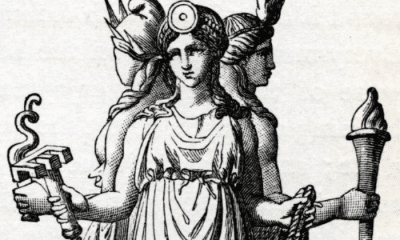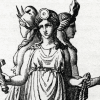Greek
How Long was Odysseus with Circe?
His stay with Circe was one of the longest stops on Odysseus’s ten-year journey, but how long did he stay with the enchantress of Aeaea?
The Odyssey recounts the ten-year long voyage of the king of Ithaca after the Trojan War. The war itself had lasted a decade, and it would take just as long for Odysseus to return to his kingdom, wife, and child.
Much of this time, however, would not be spent on a ship. Odysseus had two lengthy stays with magic-using goddesses during his long journey.
The first of these was with Circe, who is usually described as an enchantress rather than a goddess. She used spells and potions to trap men on her island, but with Odysseus she was forced to act differently.
The king of Ithaca spent a full year in Circe’s company. Homer claimed the time was so pleasant that Odysseus almost forgot his mission to return to his family entirely.
He returned to Circe’s island once more during his trek, but stayed for only a few days before setting sail once more. According to some writers, however, after his death the hero was given a second chance to enjoy the peace of Circe’s island home.
Odysseus’s Time With Circe
The enchantress Circe was one of the most memorable characters encountered by the hero of the Odyssey. While she initially posed a threat to the crew, she ended up being a great benefactor.
When Odysseus and his men first landed on her island, Aeaea, they saw chimney smoke coming from within the forest. He sent men to investigate, but only one returned.
Eurylochus ran back to the ship after some time with a horrifying tale. The men had come to house with a multitude of wild animals lounging in the yard and were met by a beautiful woman who invited them in for a meal.
Eurylochus had been the only one to hang back, staying out of the mysterious woman’s sight. While the other men had been eager for a good meal after months at sea, the youngest member of the crew had mistrusted the unusual place.
He had waited for his comrades outside, but the men had not emerged from the house. Instead, Circe had driven a herd of crying pigs out to the yard and locked them behind a fence.
The crewmen who had remained at the ship wanted to set sail at once when they learned that their companions had fallen prey to a sorceress, but Odysseus would not leave without rescuing his men.
Rather than risk more of his crew’s lives, Odysseus went to the house alone. On the way, he was met by Hermes who told him how to avoid falling victim to Circe’s spells.
Odysseus took an herb called moly to counteract the potion of forgetfulness Circe hid in her food. When she pulled out her wand, he challenged her with his sword.
To save her own life, Circe invited him into her bed. He agreed, only after making her swear that she would never again try to harm him.
Circe had been told before that the king of Ithaca would be the only man to ever resist her spells. Knowing Odysseus’s identity, she welcomed him as a guest instead of a captive.
Circe restored the men, making them all younger and stronger than they had been before. She showed them to a comfortable cave, which they made their home.
Odysseus remained with Circe in her home. They lived as husband and wife for a year and the hero was so content that he almost forgot his duty to return home to Penelope and their son.
His men reminded him, however, and after a year of comfort they prepared to set sail again. Circe was disappointed to see him leave, but helped him on his way.
In addition to giving him provisions for the journey, she told him how to proceed. Knowing his way had been blocked by supernatural means, she advised him to sail to the Underworld to learn how to proceed and taught him the magic needed to survive the trip.
Odysseus did as she instructed and returned to Aeaea to rest before continuing to Ithaca. Although he returned to Circe, it was a short stay.
She also told him of the next dangers he would face, the passage between Scylla and Charybdis. Her insight helped the majority of the crew survive that danger.
According to some later writers, Odysseus spent a year of his life with Circe but returned to her island after his death.
Circe had born a son named Telgonus when Odysseus lived with her. When he set off to find his father years later, he tragically killed him in a case of mistaken identity.
Telgonus, Penelope, and Telemachus took the Ithacan king’s body to Aeaea.
Some writers claimed that Circe and his family buried Odysseus on the island. Out of respect for their loyalty and love, Circe made Penelope and Telemachus immortal.
Another version of the story said that Circe used her magic to bring Odysseus back to life and his son, Telemachus, married one of Circe’s daughters. The family lived on Aeaea for several years.
When Telemachus and Circe were both killed, though, Odysseus took his own life in grief.
My Modern Interpretation
The year Odysseus spent on Aeaea was one of two long periods spent in one place during his journey. His stay with Calypso lasted for seven years, meaning he spent a total of three years at sea during his ten-year journey.
To Homer, his year with Circe was the more pleasant of the two, however. Circe was a gracious and welcoming hostess once she learned of Odysseus’s identity.
More importantly, she was unlike Calypso in that Odysseus was never her captive. While Calypso had the means to build a raft and let Odysseus leave her island, she hid this from him until forced to do so by Zeus.
The year Odysseus spent on Aeaea was described by Homer as so peaceful and pleasant that he almost forgot any intention to leave. With Calypso, however, Odysseus had been depressed and longed for home.
In later times, however, this favorable view of Circe changed. Writers painted her not as a benevolent figure how aided Odysseus on his journey, but as a wicked and dangerous seductress.
Even in ancient Greece, philosophers who read Homer’s works sometimes had a negative view of Circe. Socrates, for example, saw the episode as a loss of self-control.
The crew of Odysseus’s ship had been turned to pigs because they heedlessly accepted Circe’s food. Even though he knew Circe could be dangerous, Odysseus too had been lured by the comforts of her home.
Some writers claimed that gluttony was not the only vice the men fell victim to. The herb of forgetfulness had been put into their wine, leading to an interpretation that they had given in to drunkenness and become bestial as a result.
Over the next thousand years, the character of Circe was interpreted more as a femme fatale than a helpful hostess. Renaissance writers accused her of prostitution and claimed Odysseus had fallen into the sin of lust during his year with her.
Homer painted the year spent with Circe as the most safe and pleasant part of his long voyage. He drew a clear contrast between the respect Circe showed in helped Odysseus make his way and the possessive nature of Calypso.
In the modern era, however, the view of Circe is much different. Influenced by later writer’s definitions of sin and vice, readers today are more likely to see Circe as a dangerous influence who lured Odysseus away from his family.
In Summary
According to Homer, one year of Odysseus’s decade-long journey was spent with the enchantress Circe.
While she initially posed a threat to the crew, she soon became a gracious hostess and benefactor to the Ithacan king and his men. While they were free to leave at any time, Odysseus enjoyed a year of comfort with the goddess.
When his men reminded him of his duties, he agreed to leave Aeaea. He visited once more for a brief rest before continuing on his perilous journey home.
According to some stories, Odysseus was brought back to the island after his death. Some claimed he was taken there for burial, while others maintained that Circe brought him back to life and they spent a few years as a family unit.
The year spent with Circe was depicted much differently by Homer than the seven years Odysseus spent on the island of Calypso. While the enchantress helped him on his way and made his time with her pleasant, the nymph kept him as an unhappy prisoner to her obsessive love for him.
In later years, however, this view of Circe changed. Now she is often interpreted as a seductress who made Odysseus and his men forget their homes and families while lost in the vices of gluttony, drunkenness, and lust.



